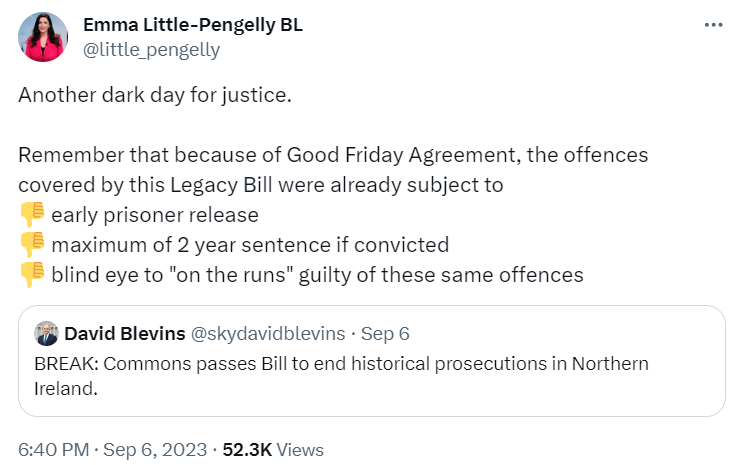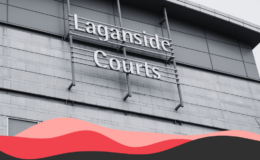- There is no legislative link between the GFA and the letters sent to OTRs.
- However, politically there is a clear and explicit line leading from the Agreement to the comfort letters.
- The letters were not intended as an amnesty – and a judge ruled they did not represent one. This is in marked contrast to both the intent and execution of the Legacy Act.
- The comfort letters gained public prominence because administrative failures meant John Downey received a letter in error. This put a halt to his criminal trial in connection with the 1982 Hyde Park bombings. A civil court later found him culpable for multiple deaths.
In a post on social media on 6 September, DUP MLA Emma Little-Pengelly claimed:
“Remember that because of Good Friday Agreement, the offences covered by [Westminster’s 2023] Legacy Bill were already subject to… early prisoner release… maximum of two year sentence if convicted… [and a] blind eye to “on the runs” guilty of these same offences.”

Is it true that, because of the Belfast/Good Friday Agreement, a blind eye was turned to “on the runs” (or OTRs) suspected of offences covered by the recent Legacy Act?
This claim has two strands – the main one being that the OTRs issue was a consequence of the Belfast/Good Friday Agreement, and a subsidiary claim that a “blind eye” was turned to those who received OTR letters.
From a legislative point of view, there is no link between the GFA and the OTRs issue.
Politically speaking, there is clear evidence to show they are related and that the OTR letters emerged from negotiations that took place in the aftermath of the Belfast/Good Friday Agreement. The letters were a by-product of the Agreement not fully dealing with potential suspects who had not been charged or had not been convicted.
Turning a ‘blind eye’ is generally accepted to mean pretending not to notice that something bad or illegal is happening so that nothing will have to be done about it.
However, there is no clear evidence that the comfort letters amounted to a ‘blind eye’ being turned to the OTRs. Instead, they were letters of assurance telling individuals they were not actively wanted for serious offences on the basis of evidence known to the authorities at the time the letter was drafted. They stipulated that, if new evidence became available, police and prosecutors might change their position.
In the most high-profile OTR case a murder trial collapsed because the defendant had erroneously received a letter of assurance that he was not wanted for serious offences on the basis of available evidence. Ultimately it was an administrative error that blocked the trial. In his ruling on this matter, Mr Justice Sweeney said “The standard [comfort] letter did not amount to an amnesty as such.”
- Legacy Act
The Northern Ireland Troubles (Legacy and Reconciliation) Act 2023 was passed by the UK Parliament a few weeks after Emma Little-Pengelly’s post. By “Troubles”, it means the period from 1 January 1966 to 10 April 1998 (the date of the Belfast/Good Friday Agreement) and by “serious offence” it means an offence causing death or serious harm (under the law of any part of the UK).
The Act also established an independent Commission for Information Recovery, limits criminal investigations and legal proceedings, extends the Prisoner Release Scheme and provides for experiences to be recorded and memorialised.
The key area of controversy is the “limitation of criminal investigations and legal proceedings”, which in practice means that no such investigations or proceedings may be begun except via a review through the Commission formed under the Act; those providing information and a full account to the Commission will in practice be granted immunity if they request it. Inquests into Troubles-related deaths must also end and may not be begun.
- Sentences Act 1998
The Belfast/Good Friday Agreement of 10 April 1998 was in fact two agreements: an accord emerging from multi-party talks, and a treaty between the UK Government and the Government of Ireland.
Under the Agreement, both governments and all parties committed to “exclusively democratic and peaceful means of resolving differences on political issues” and to “use any influence they may have” to bring about the decommissioning of all paramilitary arms within two years.
The Governments agreed to the release on licence of prisoners serving sentences in connection with the action of paramilitary groups in return for unequivocal ceasefires.
This led to the Northern Ireland (Sentences) Act 1998 – and early release for prisoners. Qualifying offences were “scheduled” (i.e. related to the Troubles) and had to have occurred before 10 April 1998.
- “On the Runs”
The concept of “On The Runs” (OTRs) became public in early 2014 when the trial of John Downey, accused of murder in respect of the 1982 Hyde Park bombings, collapsed.
The indictment against Mr Downey was stayed by the judge, Mr Justice Sweeney, who referred to letters dated 15 June 2000 from the then Prime Minister’s Chief of Staff Jonathan Powell to then Sinn Féin President Gerry Adams which represented decisions by the chief legal officers in England & Wales.
The letters were addressed to people outside (or supposed to be outside) the UK, known as “On The Runs”, and they suggested that there was insufficient evidence “currently available” for prosecution; they did note, however, that new evidence may arise including statements by any addressees implicating themselves.
By March 2002 Sinn Féin had provided a list of 161 “On The Runs”, of whom 47 had been cleared, 10 who were connected to sufficient evidence for questioning, and 12 still faced a requirement to prosecute according to the Director of Public Prosecutions in Northern Ireland.
Further letters were issued in subsequent years. Mr Downey received one in 2007 – which told him he was not wanted “on the basis of evidence currently available” when in fact he was still wanted by the Metropolitan Police.
This letter, sent in error, was the chief factor in the collapse of Mr Downey’s trial.
- Links to the Belfast/Good Friday Agreement
The Belfast/Good Friday Agreement neither mentions OTRs nor the letters some would later receive saying they were not currently wanted for prosecution.
Legislatively speaking, there is no direct link between the Belfast/Good Friday Agreementand the OTRs letters. Politically speaking, things are different. Mr Justice Sweeney’s judgement notes:
“The Good Friday Agreement did not, however, deal with those who were suspected of (but not charged with) relevant offences prior to the Good Friday Agreement, or who had been charged with such offences but had thereafter escaped, or who had been convicted of such offences and thereafter escaped. A number were the subject of extradition proceedings. They became known collectively as “on the runs” or (as indicated above) “OTRs”.
“A second phase of negotiations began in July 1998. It was during those negotiations that the position of the OTRs was addressed. Sinn Fein argued, inter alia, that given the fact that many of the cases were very old, and given the introduction of the early release scheme by the 1998 Act, the position of the OTRs was anomalous. The more so, it was said, as a number of the OTRs were strong supporters of the Good Friday Agreement, whose presence in Northern Ireland, free from the risk of arrest, would further the peace process.”
On the one hand, this highlights how the issue of OTRs was distinct from the Belfast/Good Friday Agreement, and how the letters received by some OTRs were a by-product of the fact that the Agreement had not dealt with this issue. Based on that, it is arguable that the GFA and OTR letters are completely separate.
On the other, the incongruity between the situations of those convicted of serious Troubles-related offences and those concerned that they may be under investigation for similar offences that led to the development of the letters scheme. In that sense, the letters are a consequence of the Agreement and, more broadly, the peace process itself.
The Belfast/Good Friday Agreement is mentioned several times in the ruling, including in how its substance was a reference point for further negotiations in the peace process. In particular, the ruling quotes a statement provided to the court by Sinn Féin MLA Gerry Kelly, saying:
“Sinn Fein for whom I speak in this statement emphasises that it is impossible to overstate the importance of the assurances given to the 187 recipients, which included John Downey, being maintained. These were essential in the achievement of the series of agreements that began with the Good Friday Agreement in 1998, and were consolidated in… the commencement of the Northern Ireland Assembly in 2007.”
For these reasons, the main claim is accurate with consideration.
- “Blind eye”?
Did the OTR letters really mean authorities were deliberately ignoring evidence or avoiding possible prosecutions for those “guilty” of serious offences?
FactCheckNI found no clear evidence that this was the case.
Mr Downey’s trial for the Hyde Park bombings collapsed. He faced no criminal trial in connection with those murders, let alone a guilty verdict, but in 2019, he was found liable for the bombings in a civil case.
However, Mr Downey received his letter with respect to the Hyde Park bombings in error. The OTR letters were not intended as an assurance that evidence that could lead to a prosecution was being ignored, or that further investigations would not take place, rather that the subject was not wanted at the time the letter was issued.
One of the “core facts” identified in Mr Justice Sweeney’s ruling was that:
“The standard letter did not amount to an amnesty as such. However, its terms (and in particular the references to the SSNI and the Attorney General) were intended to and did make clear that it was issued in the name of the Government and that the assurances within it could be relied upon with confidence as meaning what they said, namely an unequivocal statement that the recipient was not wanted ‐ with the obvious implication from the remainder that thus the recipient would not be arrested or prosecuted unless new evidence came to light or there was a new application for extradition.”
The OTRs letters were not suggesting a “blind eye” was being turned towards serious offences. However, they were arguably poorly-worded and not enough care was taken to clarify or codify what amounts to “new evidence”.
Perhaps the clearest indication that this is true comes from the fact Mr Downey was charged with murder in relation to the Hyde Park bombings, having previously received an OTR letter, notwithstanding the fact those proceedings collapsed.
Even though the collapse was as a result of the letter he received, the letter itself was a result of administrative failures that led to unintended consequences.
- Legacy Act comparisons
Provisions for the offences committed by recipients of OTR letters were therefore very different from those introduced under the Legacy Act for offences covered by its terms.
The former constituted a one-off description of the status of the given individual at the time – it did not grant an amnesty. The latter constitutes a comprehensive limitation on criminal investigations and legal proceedings including the mandatory cessation of any existing Troubles-related inquests and the prevention of any new inquests being started.
In this respect the situation with the OTRs is in contrast to the Legacy Act, which places real limits on the potential prosecutions of criminal acts.
The subsidiary claim is inaccurate with consideration.




